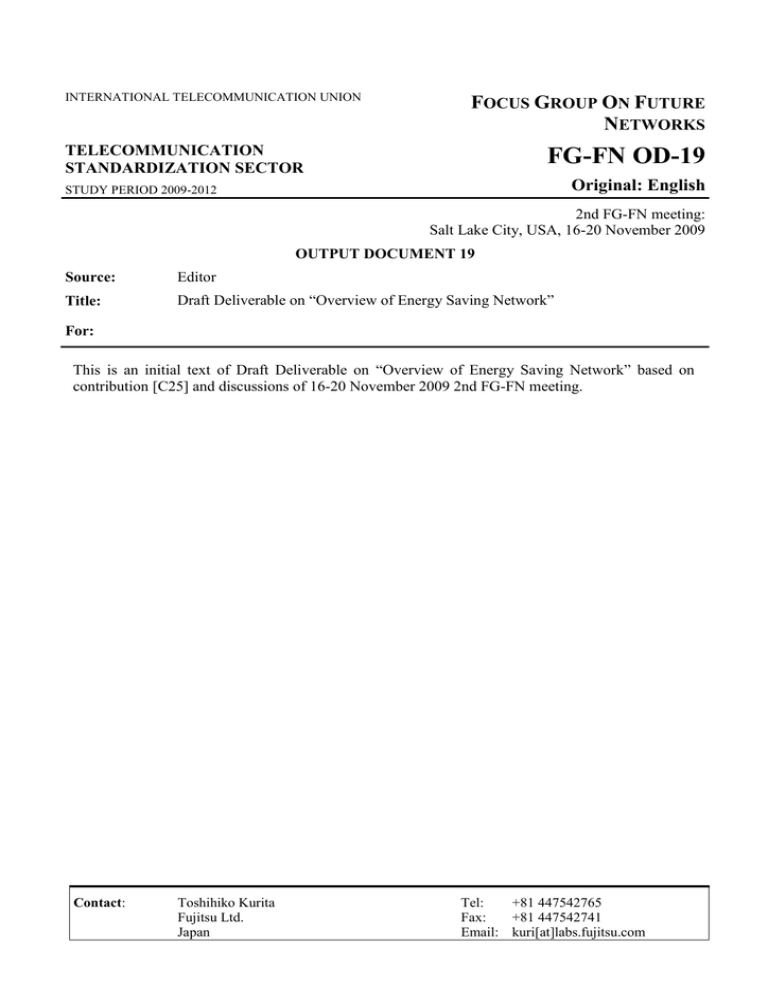FG-FN OD-19 F G O
advertisement

INTERNATIONAL TELECOMMUNICATION UNION FOCUS GROUP ON FUTURE NETWORKS TELECOMMUNICATION STANDARDIZATION SECTOR FG-FN OD-19 Original: English STUDY PERIOD 2009-2012 2nd FG-FN meeting: Salt Lake City, USA, 16-20 November 2009 OUTPUT DOCUMENT 19 Source: Editor Title: Draft Deliverable on “Overview of Energy Saving Network” For: This is an initial text of Draft Deliverable on “Overview of Energy Saving Network” based on contribution [C25] and discussions of 16-20 November 2009 2nd FG-FN meeting. Contact: Toshihiko Kurita Fujitsu Ltd. Japan Tel: +81 447542765 Fax: +81 447542741 Email: kuri[at]labs.fujitsu.com -2FG-FN OD-19 Overview of Energy Saving Network Summary This document describes the overview of energy saving network for Future Networks. Table of Contents 1. Scope 2. References 3 Definitions 3.1 Terms defined elsewhere 3.2 Terms defined in this document 4. Abbreviations and acronyms 5. Conventions 6. Introduction to Energy Saving Network 7. Technology review 8. Service requirements 9. Capability requirements 10. Functional requirements -3FG-FN OD-19 Overview of Energy Saving Network 1 Scope This document includes: Technology review of Energy Saving Network Service requirements of Energy Saving Network Capability requirements of Energy Saving Network Functional requirements of Energy Saving Network 2 References The following ITU-T Recommendations and other references contain provisions which, through reference in this text, constitute provisions of this Recommendation. At the time of publication, the editions indicated were valid. All Recommendations and other references are subject to revision; users of this Recommendation are therefore encouraged to investigate the possibility of applying the most recent edition of the Recommendations and other references listed below. A list of the currently valid ITU-T Recommendations is published regularly. The reference to a document within this Recommendation does not give it, as a stand-alone document, the status of a Recommendation. [1] ITU-T Contribution FG-FN C-25 (2009) [2] International Telecommunication Union, “ICT and Climate Change,” April 2008 3 Definitions 3.1 Terms defined elsewhere TBD 3.2 Terms defined in this Recommendation TBD 4 TBD Abbreviations and acronyms 5 Conventions TBD -4FG-FN OD-19 6 Introduction to Energy Saving Network Ways of resolving global warming issues that include reduction of carbon dioxide emissions are becoming increasingly important. While the use of network is considered a prospective means to reduce CO2 emissions in the fields of telework and supply chain management (SCM), it will increase the volume of traffic flowing into networks accordingly. The total volume of traffic of broadband subscribers in Japan as of 2025 is estimated to increase by 190 times that of 2006, which will cause estimated network power consumption in 2025 is predicted to be 13 times the 2006 level. So energy-saving technologies that reduce network power consumption is becoming increasingly important. . 7 Technology review TBD 8 Service requirements TBD 9 Capability requirements To control the power consumption, the following capabilities are considered necessary: 1) Restraint of increasing capacity needs of networks 1-1) Reduce the volume of traffic to be forwarded 1-2) Peak-shift the traffic as much as possible 2) Improvement of power consumption efficiency of the entire network 1-1) Minimize device usage for traffic dynamics 1-2) Forward the traffic with less power 10 Functional Requirements Management Functions Device Control Minimize Energy Costs Status Monitoring Network Devices - Routing paths - Function usage etc. (Routers, Switches, etc.) - Traffic - Availability etc.

